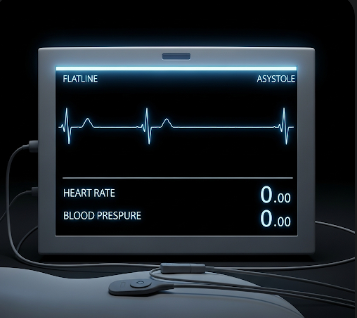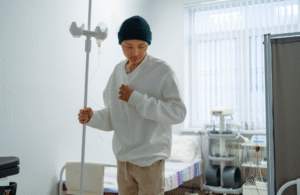Overview
Asystole is a life-threatening cardiac condition characterized by the complete absence of electrical activity in the heart, resulting in no heartbeat, no blood circulation, and no pulse. It is often referred to as a “flatline” on an electrocardiogram (ECG) and represents a form of cardiac arrest. Immediate medical intervention is critical, as survival rates decrease rapidly without prompt resuscitation.
In South Korea, emergency departments, cardiology units, and advanced pre-hospital care teams provide rapid recognition and management of asystole, using advanced life support protocols to maximize chances of survival.
Key Facts
Highlights:
➡️ Asystole indicates complete cessation of cardiac electrical activity.
➡️ It is a non-shockable cardiac arrest rhythm, meaning defibrillation alone is ineffective.
➡️ Immediate cardiopulmonary resuscitation (CPR) and medications are essential for survival.
➡️ Commonly associated with severe heart disease, electrolyte imbalances, or prolonged hypoxia.
➡️ South Korea follows international resuscitation guidelines (e.g., ACLS) for emergency care.
What is Asystole?
Asystole is the absence of ventricular depolarization, meaning the heart muscles are not receiving electrical signals to contract. On an ECG, this appears as a flatline, indicating no measurable cardiac activity.
Key features include:
- No detectable pulse or heartbeat
- No blood pressure or cardiac output
- Often preceded by severe bradycardia or other arrhythmias
- Immediate recognition is critical to initiate resuscitation efforts
Asystole differs from ventricular fibrillation, where chaotic electrical activity is present, because there is no electrical activity to restore through defibrillation.
What Symptoms are Related to Asystole?
Symptoms of asystole are usually sudden and severe, often occurring in the context of cardiac arrest:
- Loss of consciousness within seconds
- Absence of pulse or heartbeat
- No breathing or abnormal respiratory patterns
- Cyanosis (bluish discoloration of lips, skin, or extremities)
- Dilated, non-reactive pupils
- Collapse or sudden cardiac arrest
Since asystole is a medical emergency, symptoms often present immediately, and survival depends on rapid intervention.
What Causes / Possible Causes of Asystole?
Highlights:
➡️ Severe Heart Disease: Myocardial infarction, advanced heart failure, or cardiomyopathy.
➡️ Hypoxia: Oxygen deprivation due to respiratory failure or suffocation.
➡️ Electrolyte Imbalances: Abnormal potassium, calcium, or magnesium levels affecting cardiac conduction.
➡️ Acidosis: Severe metabolic or respiratory acidosis disrupting electrical signaling.
➡️ Drug Overdose or Toxicity: Certain medications, such as beta-blockers or calcium channel blockers.
➡️ Trauma: Blunt or penetrating chest injury causing cardiac arrest.
➡️ Hypothermia: Severely reduced body temperature affecting cardiac activity.
➡️ Pulmonary Embolism: Massive blockage preventing adequate circulation.
When Should I See My Doctor?
Highlights:
➡️ Asystole is an immediate medical emergency—call emergency services immediately.
➡️ If you have risk factors for cardiac arrest (history of heart disease, severe electrolyte imbalances, or drug overdose), seek regular medical evaluation.
➡️ For patients recovering from cardiac events, monitor for warning signs such as severe chest pain, syncope, or irregular heartbeat.
➡️ Family members or caregivers should be trained in CPR and aware of emergency protocols.
➡️ Early intervention and preventive care can reduce the risk of asystole in high-risk individuals.
Care and Treatment
Immediate action is required, following advanced cardiac life support (ACLS) protocols:
Highlights:
➡️ Cardiopulmonary Resuscitation (CPR): High-quality chest compressions to maintain blood flow to vital organs.
➡️ Medications: Intravenous epinephrine is administered to stimulate cardiac activity.
➡️ Identify and Treat Reversible Causes (Hs & Ts):
- Hs: Hypovolemia, hypoxia, hydrogen ion (acidosis), hypo/hyperkalemia, hypothermia
- Ts: Tension pneumothorax, tamponade, toxins, thrombosis (pulmonary or coronary)
➡️ Defibrillation: Not indicated for asystole as it is a non-shockable rhythm.
➡️ Advanced Airway Management: Ensuring oxygenation and ventilation during resuscitation.
➡️ Post-Resuscitation Care: If spontaneous circulation is restored, intensive care monitoring, hypothermia therapy, and treatment of underlying causes.
➡️ Continuous Monitoring: ECG, vital signs, and laboratory tests to prevent recurrence.
Treatment Options in Korea
South Korea provides state-of-the-art emergency and cardiac care for patients experiencing asystole:
Highlights:
➡️ Emergency Medical Services (EMS): Rapid response, pre-hospital CPR, and advanced airway management.
➡️ Cardiology and Critical Care Units: ACLS-trained teams for in-hospital resuscitation.
➡️ Advanced Diagnostic Tools: ECG, echocardiography, lab tests, and imaging to identify underlying causes.
➡️ Medication and Life Support: Intravenous epinephrine, oxygen therapy, and mechanical ventilation.
➡️ Intensive Care Post-Resuscitation: Comprehensive monitoring for neurological and cardiac recovery.
➡️ Training Programs: CPR and emergency response education for healthcare providers and the public.
➡️ Medical Tourism Support: Multilingual emergency care, treatment planning, and follow-up for international patients.













